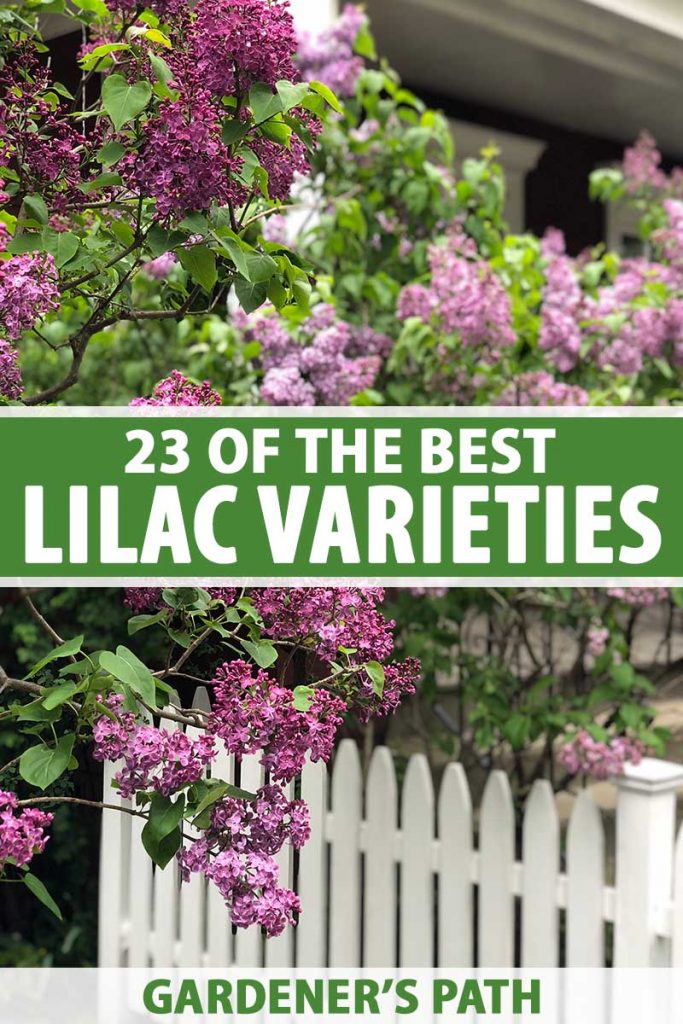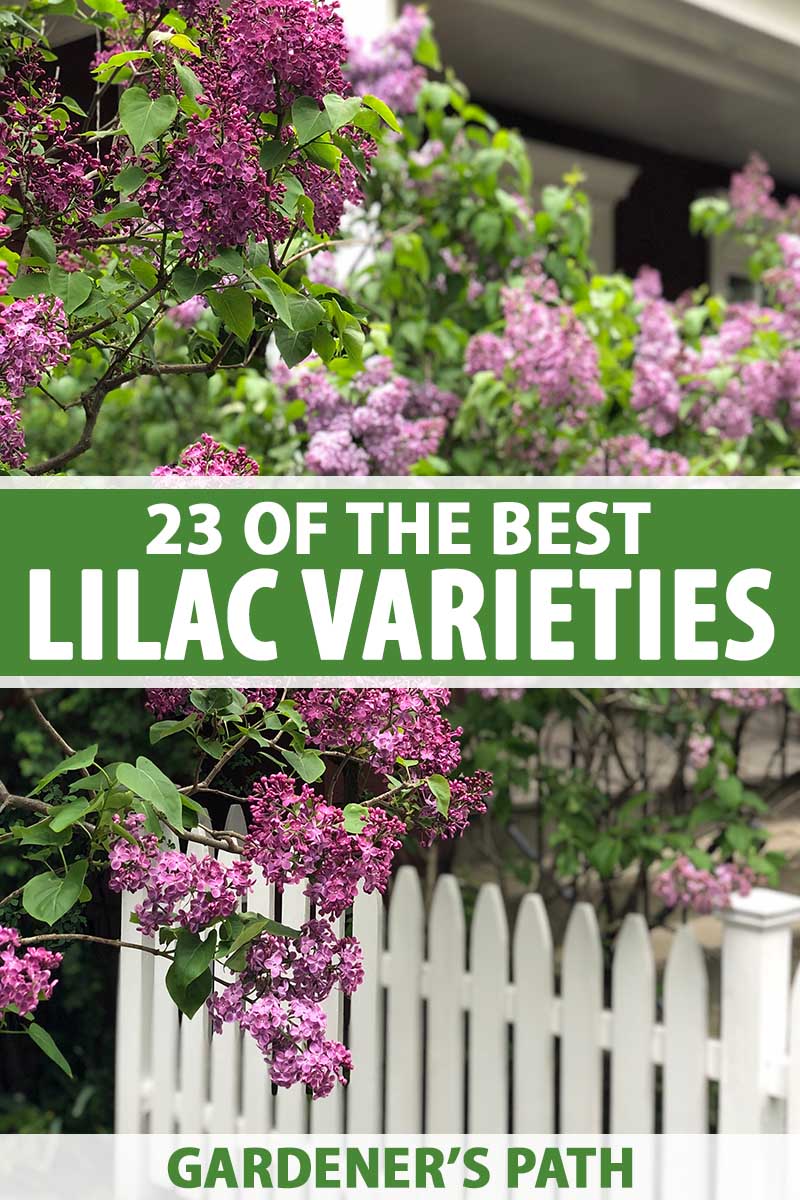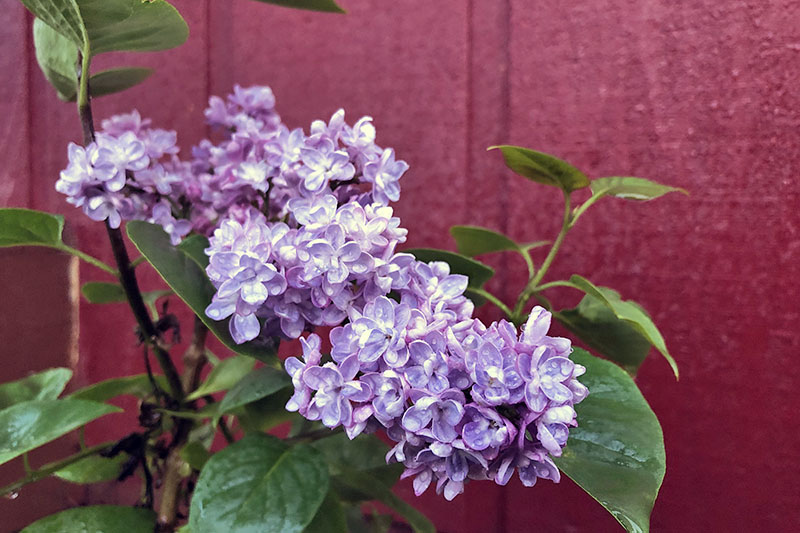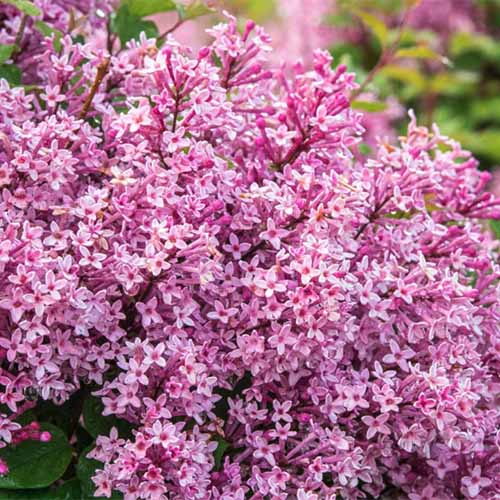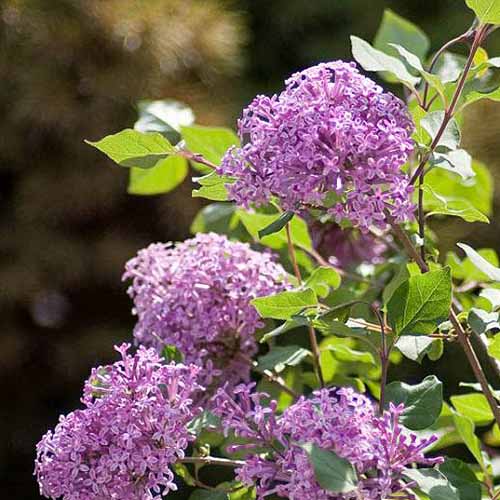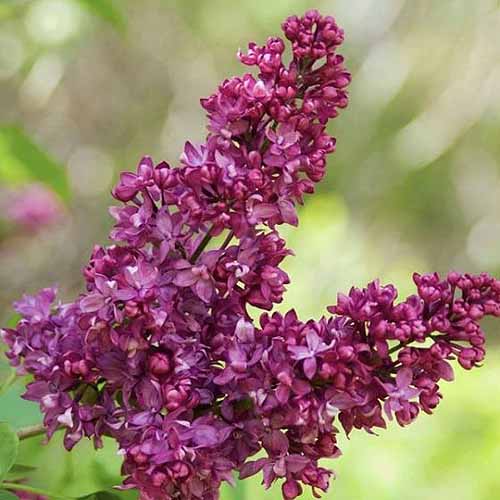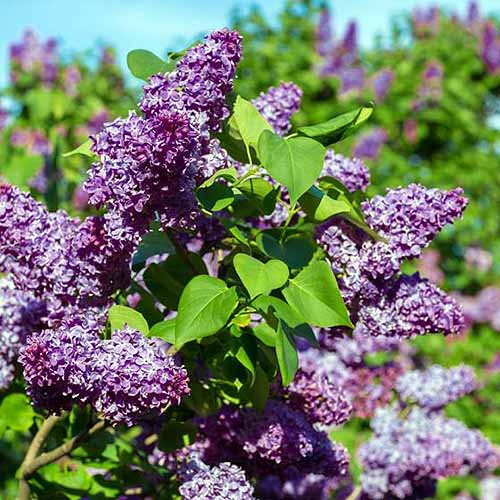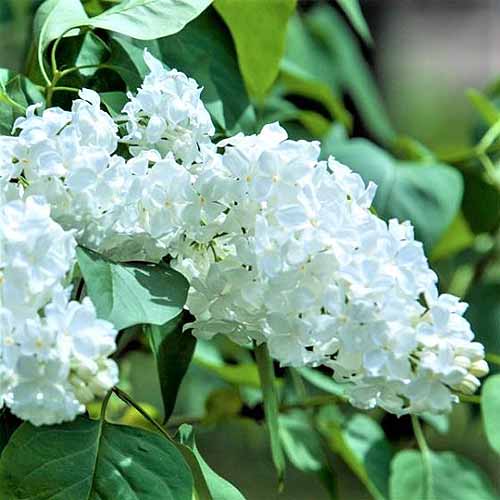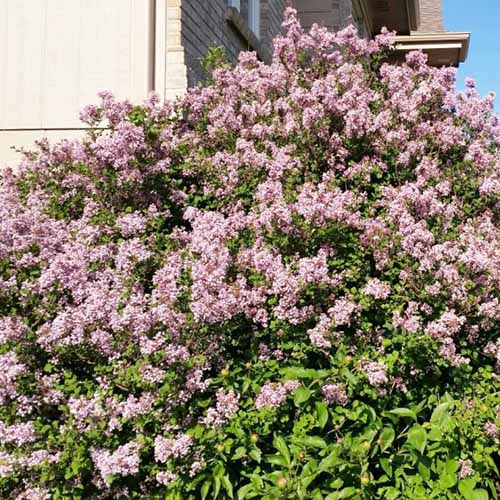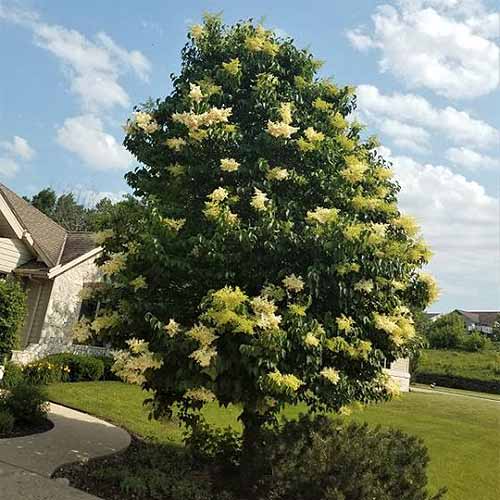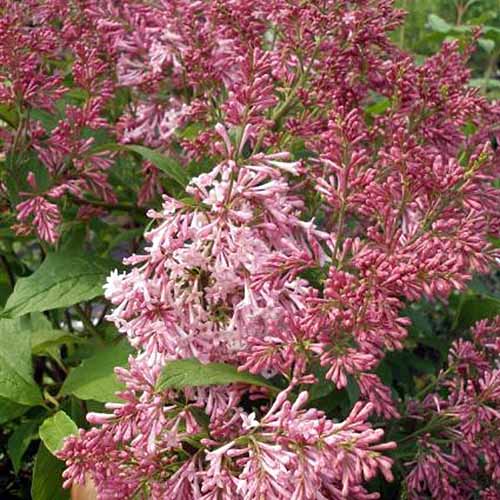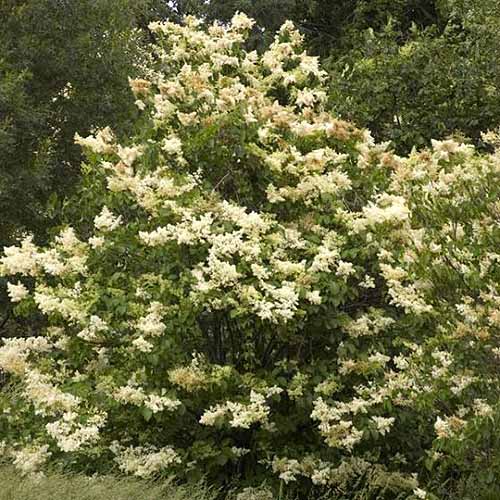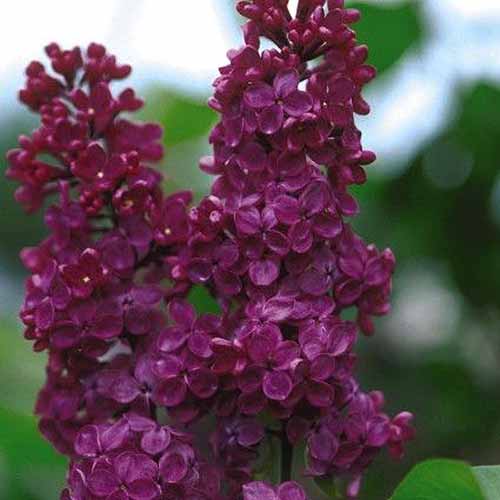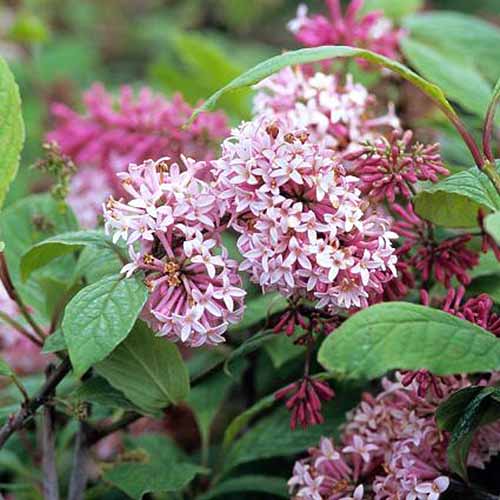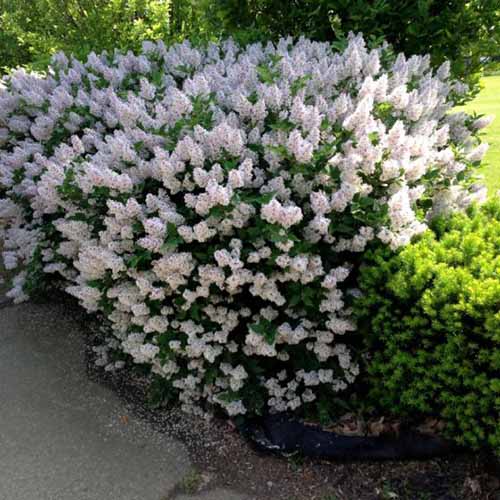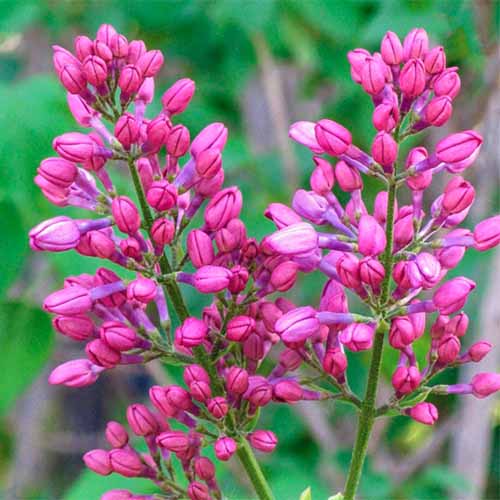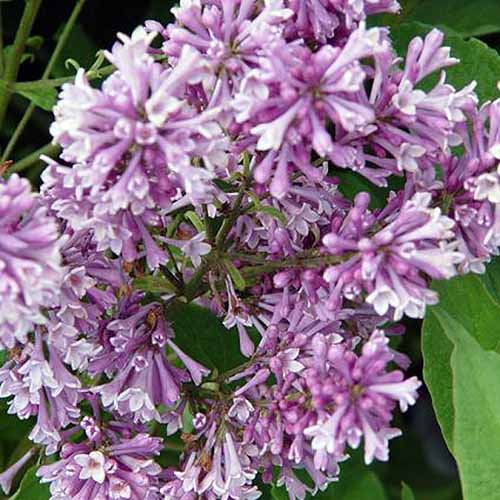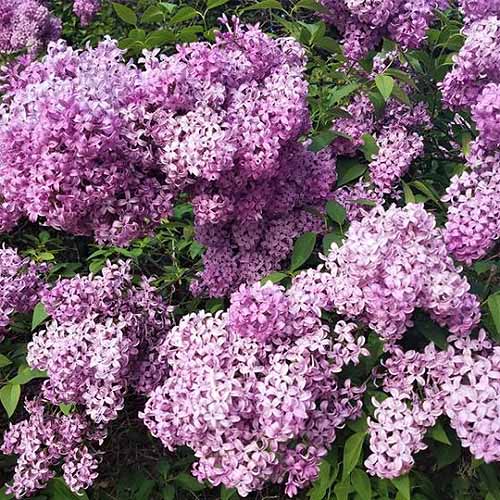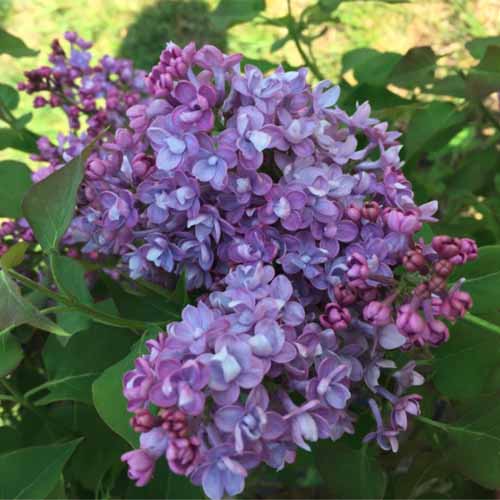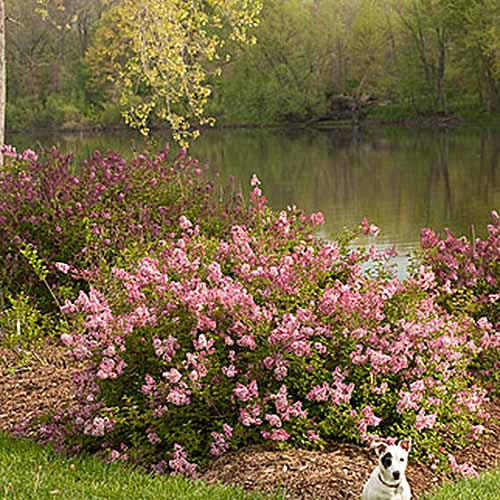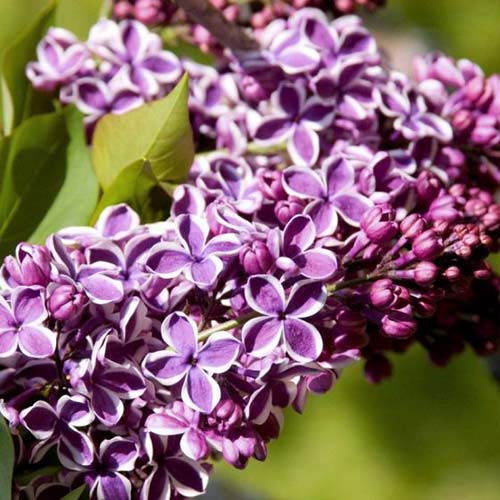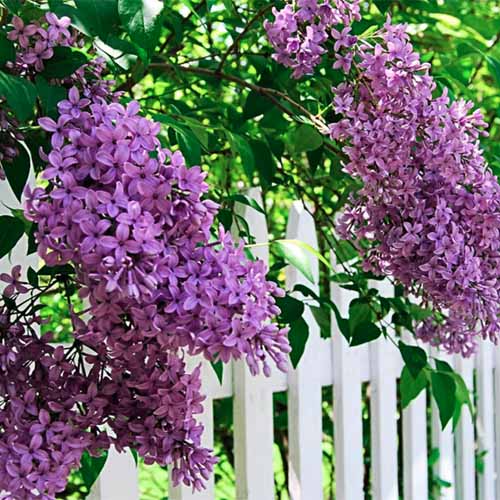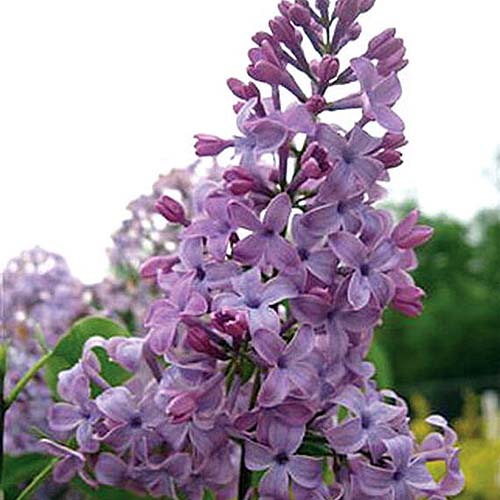I loved the zipline, but my favorite part was the little platform high in the spruce tree. I’d go up there to read books and eat snacks. Just below the tree stood a fragrant lilac bush that became the steady backdrop of every spring day I spent up on the platform. We link to vendors to help you find relevant products. If you buy from one of our links, we may earn a commission. When I peruse nurseries each spring, there are always several different types, and it can be hard to choose between them. Which are the most fragrant? Which will thrive in my growing zone? I suspect you have these questions, too. In order to flower, a lilac needs over 2,000 chill hours below 45°F during the winter, which makes it the ultimate cold-weather shrub. Due to its love for chilly temperatures, I would never think to associate it with an olive tree.
However, deciduous, perennial lilacs are part of the olive family, Oleaceae. Most lilacs thrive in Zones 3-7, but some are hardy to Zone 2. Other cultivars, bred specifically for warmer weather, grow well in Zones 8 and 9 – some even in parts of Zone 10. There are twelve species in the genus Syringa, and if you’re just getting started, you can learn all about how to cultivate them in your garden in our guide to growing lilacs. Swedish scientist Carl Linnaeus first named the genus in 1753. The word “syringa” comes from the ancient Greek word “syrinx,” which means pipe or tube. It refers to the mythological nymph, Syrinx, who changed into hollow reeds in order to escape the lustful advances of the god Pan. Thus, Syrinx gave us words for hollow things, like syringes – and the branches of lilac shrubs, which are hollow yet strong. Lilacs are known for their panicles of purple, pink, or white flowers, and their deep green foliage, which is heart-shaped on some cultivars. In the United States, the most commonly grown species is S. vulgaris, the common lilac. Many of the lilacs described below are cultivars of S. vulgaris and are called “French hybrids” or “French lilacs.” They are intraspecific crosses, which means they are not crossed with a different species. Many of these originated in France, thanks to the efforts of Victor Lemoine and his wife Marie in the 1870s. Their son and grandson continued to breed lilacs, and between them the family introduced over 200 cultivars between 1876 and 1953. The name “French hybrid” has stuck even though many were, and still are, also cultivated in the United States and other European countries. French hybrids may be single flowered with four petals on each bloom, but some cultivars are double-flowered for an extra-full, lush look with as many as 12 petals on a single flower. Most French hybrids grow to between four and 20 feet tall at maturity. Some have a compact, upright growth habit, while others tend to spread. Some may be described as reblooming, which means they flower in the spring followed by a further flush of color in late summer. Victor Lemoine also hybridized S. vulgaris with the Chinese lilac, S. oblata, to produce what are often called Hyacinflora lilacs, S. x hyacinthiflora. These early-blooming varieties have flowers that resemble tiny hyacinths. Another notable plant breeder from Canada, Isabella Preston, produced 82 different hybrid lilacs between 1912 and 1946. These are commonly referred to as Preston lilacs, or S. x prestoniae. Other common species include:
Japanese tree lilacs, S. reticulata, are fragrant trees that grow up to 30 feet tall with a spread of 20 feet. Korean lilacs S. meyeri, aka S. pubescens, are spicy-sweet scented shrubs that grow just seven feet tall with a spread of five feet. Persian S. persica, which grows four to eight feet tall with a spread of five to 10 feet, smells delightful, and is native to Iran. S. emodi, aka Himalayan lilac, has an upright growth habit and reaches up to 16 feet tall with a spread of 13 feet and does not smell pleasant.
All are beautiful in their own right, and most give off one of the most alluring smells in the world.
1. Agincourt Beauty
Do you want blooms with huge florets to cut and and place in a vase, filling your home with the sweet smell of springtime? Then ‘Agincourt Beauty’ (S. vulgaris), which blooms from late April to early May, is the lilac for you. With the biggest individual florets of all lilac species and cultivars, ‘Agincourt Beauty’ is a vibrant violet stunner.
‘Agincourt Beauty’ This cultivar thrives in Zones 3-7 and reaches a dazzling height of 10 to 12 feet tall with a spread of eight to 10 feet. I definitely need to get my hands on an ‘Agincourt Beauty’ plant for my backyard. You can find bare roots or a live plant in a three-inch container available at Nature Hills Nursery.
2. Beauty of Moscow
For a sweet surprise, plant ‘Beauty of Moscow’ (S. vulgaris), aka ‘Krasavitsa Moskvy’ – which literally translates from Russian to “beauty of Moscow” – in your yard or garden. This shrub forms soft-pink buds that bloom into white, double-flowered blossoms. Delicately beautiful, the flowers are also highly fragrant. Cut one or two clusters from the plant, put them in a vase, and enjoy the sweet smell of springtime throughout your entire house.
‘Beauty of Moscow’ ‘Beauty of Moscow’ flowers in May. It’s hardy to Zones 3-7, reaches a mature height of 10-12 feet, with a spread of up to eight feet. You can find bare roots to plant available at Nature Hills Nursery.
3. Be Right Back
With dark pink buds that give way to large, fragrant, pink flowers, ‘Be Right Back’ (S. hybrida ‘GARlisabzar’) is a reblooming lilac that flowers in early summer and just when you think your season of color is over, blooms again in early fall.
‘Be Right Back’ ‘Be Right Back’ grows to a mature height of four feet, with a similar width. It’s hardy in Zones 4-8. You can find four-inch potted plants from Spring Hills Nursery via the Home Depot.
4. Bloomerang
Bloomerang® is a hybrid series of compact, reblooming lilacs with a rounded growth habit. Bloomerang®, S. hybrida ‘Penda,’ produces light pink, fragrant flowers in late spring, then from July puts on a spectacular show of bright purple blossoms that last until first frost.
Bloomerang® Bloomerang® does best in Zones 3-7, and reaches a mature height and width of three to six feet. Find plants in three-inch containers available at Nature Hills Nursery.
5. Charles Joly
Do you need some magenta in your life right about now? Then let ‘Charles Joly’ (S. vulgaris) deliver just that. This sweet-smelling shrub grows up to 12 feet tall with a spread of 10 feet, and thrives in Zones 3-7. But its striking double-flowered blooms are its most treasured trait.
‘Charles Joly’ Blooming begins from mid- to late spring and lasts three to four weeks. ‘Charles Joly’ received the Award of Garden Merit from the Royal Horticultural Society in 1993. You can find plants in two-inch containers available at Nature Hills Nursery.
6. Common Purple
S. vulgaris, the common lilac, is the species plant from which dozens of cultivars have been developed. It was brought to the United States from Europe in the 1700s. Blooming in late May, it’s adaptable to many types of soil. Its lavender-colored flowers give off that classic, sweet scent.
S. vulgaris I’m pretty sure we had a common lilac under the zipline tree in my childhood yard in Montana. I’ll be planting one of these shrubs, which are hardy to Zones 3-7 and grow to a height and width of eight to 10 feet, this spring. If you want to do the same, you can find bare root plants from Nature Hills Nursery.
7. Common White
If you live in Zone 2, you’re in luck: the common white variety (S. vulgaris var. alba) thrives in Zones 2-7. This is a subspecies of the purple common lilac, described above.
S. vulgaris var. alba With snow-white blooms and a heavy, heady fragrance, this shrub blooms in mid-spring to early summer and offers everything lovely about lilacs to those who prefer white to purple. The common white lilac grows eight to 10 feet tall and wide. Find bare root plants online at Nature Hills Nursery.
8. Dwarf Korean
Dwarf Korean (S. meyeri ‘Palibin’) is a popular six-foot shrub with an eight-foot spread, and I see it all the time in nurseries up here in Alaska. It’s ideal for smaller gardens or container growing, thanks so its rounded, bushy growth habit and mature height and width of four to five feet. A recipient of the Award of Garden Merit in 1993, this cultivar also won a gold medal from the Pennsylvania Horticultural Society in 2000.
Dwarf Korean The purple flowers bloom profusely in the spring and give off a sweet fragrance. They close out the summer with one light rebloom to leave you with a sweet memory until it blooms again next spring. Find bare root plants, three-inch, or five-inch containers from Nature Hills Nursery.
9. Ivory Silk
‘Ivory Silk’ is a Japanese tree lilac (S. reticulata) cultivar that produces huge, cream-colored panicles and delivers that classic lilac scent. You’ll need a lot of room in your garden if you want to grow this one, as it tops out between 15-25 feet tall with a spread of 10-15 feet.
‘Ivory Silk’ The dark reddish bark makes an attractive statement in your yard even once the leaves drop off in the fall. ‘Ivory Silk’ is hardy to Zones 3-7, blooms in June, and provides the perfect shade for a sweet-scented picnic. Find bare root plants, as well as five-inch containers, available at Nature Hills Nursery.
10. James Macfarlane
‘James Macfarlane’ (S. x prestoniae) is a Preston lilac that produces dark-pink buds that open into light-pink flowers. He grows up to eight feet tall with a spread of up to 10 feet, making him a perfect choice for a privacy hedge.
‘James Macfarlane’ Plus, he’s extra-hardy, thriving in Zones 2-7. Sweet-smelling ‘James Macfarlane’ blooms in May and June. You can find bare root plants available at Nature Hills Nursery.
11. Japanese Tree Lilac
The species S. reticulata aka Japanese tree lilac, is a multi-branched tree that produces small cream-colored flowers and deep green leaves that drape elegantly over your grassy yard. I call it the “reading lilac,” because the tree creates a cozy nook for book-lovers like me to spread a picnic blanket and curl up with a novel. Despite their small size, the early summer-blooming flowers pack plenty of scent.
S. reticulata S. reticulata grows up to a stunning 20-25 feet tall with a spread of 15-25 feet, and does best in Zones 3-7. Find bare root plants available at Nature Hills Nursery. Read more about growing this variety here.
12. Ludwig Spaeth
The deep purple-red color of ‘Ludwig Spaeth’ (S. x vulgaris) is enough to make even the hardest heart swoon. The flowers of this French hybrid are also highly fragrant. It blooms slightly later in the spring or early summer than other varieties, making it easy for you to extend your yard’s lilac show.
‘Ludwig Spaeth’ Reaching up to 10 feet tall and spreading up to eight feet wide, ‘Ludwig Spaeth’ creates a wonderful privacy hedge and does best in Zones 3-7. You can find bare root plants online via Nature Hills Nursery.
13. Miss Canada
For a pink-flowered Preston cultivar that also provides pretty foliage in the fall, try ‘Miss Canada’ (S. x prestoniae). This mid-sized shrub grows to between six and nine feet tall and five and eight feet wide. Its clusters of flowers bloom in early summer for two to three weeks.
‘Miss Canada’ The cheerful pink blossoms smell delightful, and the shrub thrives in Zones 3-7. In the fall, the leaves turn a rich yellow color. You can find bare root plants available at Nature Hills Nursery.
14. Miss Kim
‘Miss Kim’ is a cultivar of S. pubescens var. patula, a dwarf Korean lilac originally introduced by University of New Hampshire in 1954. It’s ideal for those in slightly warmer growing zones, as she thrives in Zones 4-9. This tidy shrub reaches a height and width of four to five feet and produces large, sweet-smelling blooms in a light-purple color.
‘Miss Kim’ A prolific bloomer, ‘Miss Kim’ produces flowers in the springtime, but her dark-green foliage remains attractive during the summer before it gives way to a stunning claret in the fall. You can find bare root plants, three-inch containers, or five-inch containers from Nature Hills Nursery.
15. Rosie
As peppy as her name suggests, ‘Rosie’ (S. vulgaris), wows you with her bright-pink flowers – and her heat tolerance. She’s part of the Beach Party™ series of “low chill” lilac cultivars developed by John Schoustra, a plant breeder in California.
‘Rosie’ Which is good news for those of you in warmer growing zones: with fewer chilling hours required than is typical in a lilac, she thrives in Zones 4-10. ‘Rosie’ grows up to 12 feet tall and spreads six to eight feet, and smells delightful. You can buy ‘Rosie’ in four-inch pots from Spring Hill Nurseries via the Home Depot.
16. Royalty
Do you want a light, lavender-colored cultivar that’s highly aromatic and blooms later in the spring and early summer than other varieties? Then try ‘Royalty’ (S. x josiflexa), bred in Canada by renowned horticulturist Isabella Preston in the 1920s.
‘Royalty’ While its blossoms are a lighter color, this Preston lilac’s buds are dark, giving the panicles a layered look. Hardy to Zones 3-8 and requiring slightly fewer chill hours than other varieties, ‘Royalty’ grows up to 10 feet tall and spreads up to eight feet. Find bare roots, as well as live plants in three- and five-inch containers, at Nature Hills Nursery.
17. Saugeana
‘Saugeana’ aka ‘Persian’ lilac is a hybrid cross between S. vulgaris and S. persica, sometimes listed as S x chinensis. It was first discovered in Rouen, France, in 1777 and is sometimes referred to as the “Rouen lilac.”
‘Saugeana’ ‘Saugeana’ produces pale purple flowers from mid-May with a sweet fragrance. The shrub grows four to eight feet tall and spreads all the way up to 10 feet wide. This variety adapts well to almost any soil and is hardy in Zones 3-7. Find bare root plants online at Nature Hills Nursery.
18. Scentara Double Blue
For an alluring double-flowered blossom that’s the most gorgeous blue-violet color you’ve ever seen, plant ‘Scentara Double Blue’ (S. x hyacinthiflora). This cultivar blooms in mid-spring and fills your yard with that pleasing, classic lilac scent.
‘Scentara Double Blue’ The shrub grows six to eight feet tall with a similar spread and thrives in Zones 2-8. I dream of a vase filled with these blue-purple flowers on every windowsill in my house. You can order plants in one-quart containers from Proven Winners at the Home Depot.
19. Scent and Sensibility Pink
I’m lucky enough to have a ‘Scent and Sensibility Pink’ (S. x ‘SMSXPM’) right outside my kitchen window. Each spring, it blooms in light-pink bouquets of fragrant beauty. The blooms stop coming in midsummer, but just as you start to really miss them, August brings another flush of blossoms.
‘Scent and Sensibility Pink’ ‘Scent and Sensibility Pink’ is a compact variety and only grows to about three feet high, but it can spread up to six feet, giving your garden or borders a pleasant, sprawling look. This cultivar grows best in Zones 3-7. You can find plants available at Burpee.
20. Sensation
If you adore both purple and white lilacs, why not try ‘Sensation’ (S. vulgaris)? This unique cultivar boasts purple flowers edged in white for an elegant, layered look. So beautiful is this cultivar that it was awarded the Royal Horticultural Society Award of Garden Merit in 2012. Plus, it blesses you with its beauty for a full month in mid-spring.
‘Sensation’ Lightly fragrant ‘Sensation’ is hardy to Zones 3-7, grows up to 10 feet, and spreads up to 12 feet. You can find bare root plants online at Nature Hills Nursery.
21. Sunday
For bright purple clusters of sweet-scented blossoms decorating your yard, plant ‘Sunday,’ (S. x chinensis). ‘Sunday’ blooms abundantly, causing the branches to arch over.
‘Sunday’ ‘Sunday’ blooms in early- to mid-spring and thrives in Zones 3-7. It grows up to 10 feet tall and spreads about eight feet. Find a four-inch pots available from Spring Hill Nurseries via the Home Depot.
22. Tiny Dancer
If you dream of a fragrant border that doesn’t require constant trimming to make sure it doesn’t swallow your yard, try ‘Tiny Dancer’ (S. vulgaris) aka ‘Elsdancer.’ This dwarf variety grows up to just five feet tall and three to four feet wide and produces four- to five-inch bunches of heady lavender-colored blooms.
‘Tiny Dancer’ ‘Tiny Dancer’ isn’t as cold-hardy as some other cultivars – it thrives in Zones 4-8. It’s resistant to powdery mildew, making it an ideal cultivar for those of you who live in rainy areas. Find bare root plants available at Burpee during the spring and summer months.
23. Yankee Doodle
For a classic American lilac, plant a ‘Yankee Doodle’ (S. vulgaris) in your yard. This deep-purple beauty was cultivated in 1985 by Father John L. Fiala, an avid Ohio lilac breeder, and he counted it among his favorite creations.
‘Yankee Doodle’ ‘Yankee Doodle’ grows up to 10 feet tall and spreads up to six feet. Highly aromatic, ‘Yankee Doodle’ blooms in late spring for up to four weeks and thrives in Zones 2-8. Find bare root plants available at Nature Hills Nursery.
Dreaming of Spring
There’s so much to look forward to in the springtime when you’ve got one (or five) lilac bushes or trees planted throughout your yard. If you love these plants as much as I do, try combining early bloomers with late bloomers for a near-constant rush of scent and color.
Tell me, what’s your favorite lilac variety? How many have you planted at your home? Share any tips or questions in the comment section below! And in the meantime, for more information on growing shrubs in your garden, check out these articles next:
How to Grow and Care for American Beautyberry Shrubs Why Autumn is the Best Time for Planting Shrubs 23 of the Best Variegated Shrubs for Your Landscape
© Ask the Experts, LLC. ALL RIGHTS RESERVED. See our TOS for more details. Product photos via Burpee, Nature Hills Nursery, Proven Winners, and Spring Hills Nursery. Uncredited photos: Shutterstock. With additional writing and editing by Clare Groom.
